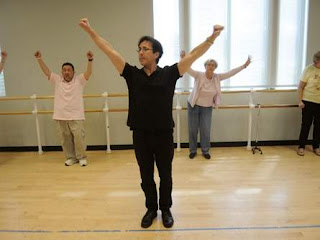Carlos Agudelo is an important person in my family. The artistic director of Ballet Spartanburg, Carlos retired after a successful career several years ago. His importance to us is as my son Quinn’s ballet teacher.
But not just any ballet teacher: Quinn started taking ballet when he was 5 after seeing a dancer on Sesame Street. He always said he wanted to do ballet so he could “pick up girls.” And here in Spartanburg, South Carolina, Quinn has had all-boys dance classes now for nine years, all taught by Mr. Carlos.
Carlos takes these classes seriously, and teaches the boys the French terms for what they are doing from the beginning. When Quinn was 7, he took a class with girls taught by another teacher. “She doesn’t use the French words, Dad,” he told me indignantly. “I know the French words.” After every class, the boys shake Mr. Carlos’s hand, and thank him. I told Carlos that if I did some of the workouts those boys do, I’m not sure I’d shake his hand.
Carlos teaches all the boys that come through the program. One of his graduates dances professionally, and regularly comes back to town to work out with the boys. Quinn is always impressed.
 |
| photo by Alex Hicks, Spartanburg Herald-Journal |
Carlos has been teaching a class for Parkinson’s patients here in town for a couple of years, too. The class is of course very different from Quinn’s: the dancers sit in chairs, and some of them are very restricted in their movement. But Carlos treats them the same way he treats his boys. He uses the French words for what they do, and he teaches the movements as though he is teaching a group of professional dancers, expecting them to do the things he does.
But as with Quinn, he teaches to their level, too. No one is made to feel inadequate, or incomplete. In an article in the local paper, Carlos said he does not view this as a therapy class, but as a dance class. “No matter how old you are or what your physical abilities are, as long as you can move, you can dance."
I observed Carlos’s class recently at a presentation by researcher Dr. Mark Stacy. In front of a crowd of about 500, Carlos and his students acted like no one was watching. Most of the members of the class were elderly, but there were a couple who seemed to be in their 50s. There were two women whose movement was very restricted.
I cried at their willingness to dance in front of such a large crowd, and thought of my father’s own nervousness about telling others of his affliction. All of them sat up as straight as they were able, on the edges of their chairs. They knew the routine, but as with Quinn’s classes, Carlos added new moves. After the half-hour session, they stood and bowed to the audience. They all thanked Mr. Carlos.
No comments:
Post a Comment